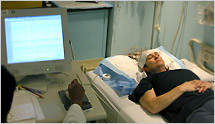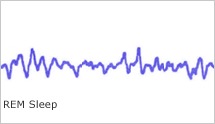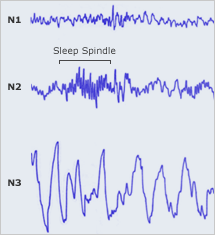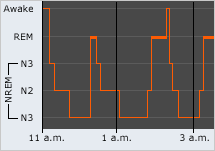Fifty years of research on brain activity and physiological patterns of sleeping has revealed a great deal about what sleep is and what it is not.
We all have at least a vague notion of what sleep is, but that doesn't mean that defining this mysterious part of our lives is simple. After all, detailed analysis of our own sleep isn't really an option, given that we rarely know that we're sleeping when we're asleep. And even if we observe the sleep of others, so much of what they experience—changes in the functions of their brains and bodies—is not easily seen from the outside.
Sleep scientists have explored these changes in depth, and their definition of sleep is tied to characteristic patterns of brain waves and other physiological functions. Not the passive state many people once considered it to be, sleep is now known to be a highly active process during which the day’s events are processed and energy is restored. Features in this section describe and explain the significance of typical sleep patterns, as well as a variety of factors that disrupt these patterns.
The Characteristics of Sleep
The Takeaway
- Sleep is a state that is characterized by changes in brain wave activity, breathing, heart rate, body temperature, and other physiological functions.
- Depending on the sleep stage, different physiological functions may be more active and variable (for example, during REM sleep), or less active and more stable (for example, during NREM.
- The reasons why we dream and the meaning of our dreams, despite scientific investigations, still largely remain a mystery.
What Is Sleep?

Every night, nearly every person undergoes a remarkable change: we leave waking consciousness and for hours traverse a landscape of dreams and deep sleep. When we wake, we typically remember little or nothing about the hours that have just passed. Except in rare instances, we never contemplate and appreciate that we are sleeping while we are asleep. Thus, although everyone sleeps, most people would be hard-pressed to precisely define sleep. All organisms exhibit daily patterns of rest and activity that resemble the daily sleep and wakefulness patterns seen in humans. From observing changes in behavior and responsiveness, scientists have noted the following characteristics that accompany and in many ways define sleep:
- Sleep is a period of reduced activity.
- Sleep is associated with a typical posture, such as lying down with eyes closed in humans.
- Sleep results in a decreased responsiveness to external stimuli.
- Sleep is a state that is relatively easy to reverse (this distinguishes sleep from other states of reduced consciousness, such as hibernation and coma).
From observations of behavioral changes that accompany sleep and simultaneous physiological changes, scientists now define sleep in humans based on brain wave activity patterns and other physiological changes as described below.
Physiological Changes During Sleep
Many physiological variables are controlled during wakefulness at levels that are optimal for the body’s functioning. Our temperature, blood pressure, and levels of oxygen, carbon dioxide, and glucose in the blood remain quite constant during wakefulness. During sleep, however, physiological demands are reduced and temperature and blood pressure drop. In general, many of our physiological functions such as brain wave activity, breathing, and heart rate are quite variable when we are awake or during REM sleep, but are extremely regular when we are in non-REM sleep.
Brain Activity. For centuries, physicians believed that sleep was a period of brain inactivity, yet research over the last 60 years has shown us that the brain remains active during sleep. There is a progressive decrease in the activation or "firing" rate of most neurons throughout the brain as sleep progresses from wakefulness to non-REM sleep. Also, the patterns of neuron firing change from a seemingly random and variable activity pattern during wakefulness, to a much more coordinated and synchronous pattern during non-REM sleep.
During REM sleep (the stage of sleep most associated with dreaming) there is an increase in the firing rate of most neurons throughout the brain, as compared to non-REM sleep. In fact, the brain in REM sleep can even be more active than when we are awake. Patterns of brain activity during REM sleep are more random and variable, similar to during wakefulness. This pattern of brain activity during REM sleep probably underlies the intense dreaming that occurs during this state.
Dr. Steven Shea describes the brain’s activity during REM sleep.
In all mammals and many other animals, sleep can be defined in much the same way that we define sleep for humans. However, there are some notable differences among species. When humans sleep, the entire brain is involved. Dolphins and whales, on the other hand, need to maintain consciousness while they sleep so they can occasionally surface to breathe. In these marine mammals, sleep occurs in only one hemisphere of their brain at a time—allowing for some degree of consciousness and vigilance to be maintained at all times.
For more information about the brain during sleep, see Natural Patterns of Sleep and Under the Brain's Control.
Body Temperature. Through a process known as thermoregulation, the temperature of our body is controlled by mechanisms such as shivering, sweating, and changing blood flow to the skin, so that body temperature fluctuates minimally around a set level during wakefulness. Just before we fall asleep, our bodies begin to lose some heat to the environment, which some researchers believe actually helps to induce sleep. During sleep, our central set temperature is reduced by 1 to 2°F. As a result, we use less energy maintaining our body temperature. It has been hypothesized that one of the primary functions of sleep is to conserve energy in this way.

Body temperature is still maintained, although at a slightly reduced level during non-REM sleep, but during REM sleep our body temperature falls to its lowest point. Curling up in bed under a blanket during the usual 10- to 30-minute periods of REM sleep ensures that we do not lose too much heat to the environment during this potentially dangerous time without thermoregulation.
Respiratory Changes. Our breathing patterns also change during sleep. When we are awake, breathing is usually quite irregular, since it is affected by speech, emotions, exercise, posture, and other factors. As we progress from wakefulness through the stages of non-REM sleep, our breathing rate slightly decreases and becomes very regular. During REM sleep, the pattern becomes much more variable again, with an overall increase in breathing rate.
Cardiovascular Activity. One of the possible functions of sleep is to give the heart a chance to rest from the constant demands of waking life. As compared to wakefulness, during non-REM sleep there is an overall reduction in heart rate and blood pressure. During REM sleep, however, there is a more pronounced variation in cardiovascular activity, with overall increases in blood pressure and heart rate. Additionally, changes in blood flow that cause erections to occur in males or swelling of the clitoris in females is characteristic of REM sleep The underlying reason for these considerable neural and physiological variations in REM sleep is currently unknown, and may be a by-product of REM-related changes in nervous system activity or related to dream content.
Increased Physiological Activity During Sleep. For the most part, many physiological activities are reduced during sleep. For example, kidney function slows and the production of urine is decreased. However, some physiological processes may be maintained or even increased during sleep. For example, one of the greatest changes induced by sleep is an increase in the release of growth hormone. Certain physiological activities associated with digestion, cell repair, and growth are often greatest during sleep, suggesting that cell repair and growth may be an important function of sleep.
Dr. Thomas Scammell describes the changes that the body goes through during a typical night of sleep.
Dreams
One of the most notable but least understood characteristics of sleep is dreaming, during which our thoughts follow bizarre and seemingly illogical sequences, sometimes random and sometimes related to experiences gathered during wakefulness. Visually intense dreaming occurs primarily during REM sleep. However, not all dreams occur during REM sleep. For example, night terrors actually occur during non-REM sleep.

Varying explanations for dreaming, as well as the meanings of dreams, have been offered by philosophers and psychologists throughout history. Even with recent scientific investigations of dreaming, our dreams still remain something of a mystery. Some experts suggest that dreams represent the replay of the day’s events as a critical mechanism in the formation of memories, while others claim that the content of dreams is simply the result of random activity in the brain.
Dr. Robert Stickgold describes the physiological underpinnings for why we might dream about the things we do.
Summary
Clearly the changes in brain activity and physiological functions during sleep are quite profound. These changes are used to help define the occurrence of sleep. Ultimately, some of these changes may help us to answer the difficult question of "Why do we sleep?” Although scientists are unsure exactly why we sleep, there are many clues about the functions that sleep serves and how getting more and higher quality sleep can improve our health and wellbeing.
To explore these ideas in more depth, see Benefits of Sleep and Consequences of Sleep Deficiency?
References
- Hobson JA, Pace-Schott EF. The cognitive neuroscience of sleep: neuronal systems, consciousness and learning. Nat Rev Neurosci. 2002; 3(9):679-93.
- Pace-Schott EF, Hobson JA. The neurobiology of sleep: genetics, cellular physiology and subcortical networks. Nat Rev Neurosci. 2002; 3(8):591-605.
Natural Patterns of Sleep
The Takeaway
- Sleep was once considered an inactive, or passive, state in which both the body and the brain "turned off" to rest and recuperate from the day's waking activities.
- Scientists have since found that the brain goes through characteristic patterns of activity throughout each period of sleep, and that it is sometimes more active when we're asleep than when we're awake.
- Understanding these patterns, and the factors that affect them, may help in making choices that will lead to better quality sleep.
Waking up to Sleep
Our bodies require sleep in order to maintain proper function and health. In fact, we are programmed to sleep each night as a means of restoring our bodies and minds. Two interacting systems—the internal biological clock and the sleep-wake homeostat—largely determine the timing of our transitions from wakefulness to sleep and vice versa. These two factors also explain why, under normal conditions, we typically stay awake during the day and sleep at night. But what exactly happens when we drift off to sleep?
Prior to the era of modern sleep research in the early 1920s, scientists regarded sleep as an inactive brain state. It was generally accepted that as night fell and sensory inputs from the environment diminished, so too did brain function. In essence, scientists thought that the brain simply shut down during sleep, only to restart again when morning came.

In 1929, an invention that enabled scientists to record brain activity challenged this way of thinking. From recordings known as electroencephalograms (EEGs), researchers could see that sleep was a dynamic behavior, one in which the brain was highly active at times, and not turned off at all. Over time, sleep studies using EEGs and other instruments that measured eye movements and muscle activity would reveal two main types of sleep. These were defined by characteristic electrical patterns in a sleeping person's brain, as well as the presence or absence of eye movements.

The two main types of sleep are rapid-eye-movement (REM) sleep and non-rapid-eye-movement (NREM) sleep. On an EEG, REM sleep, often called "active sleep," is identifiable by its characteristic low-amplitude (small), high-frequency (fast) waves and alpha rhythm, as well as the eye movements for which it is named. Many sleep experts think that these eye movements are in some way related to dreams. Typically, when people are awakened from REM sleep, they report that they had been dreaming, often extremely vivid and sometimes bizarre dreams. In contrast, people report dreaming far less frequently when awakened from NREM sleep. Interestingly, during REM sleep muscles in the arms and legs are temporarily paralyzed. This is thought to be a neurological barrier that prevents us from "acting out" our dreams.
NREM sleep can be broken down into three distinct stages: N1, N2, and N3. In the progression from stage N1 to N3, brain waves become slower and more synchronized, and the eyes remain still. In stage N3, the deepest stage of NREM, EEGs reveal high-amplitude (large), low-frequency (slow) waves and spindles. This stage is referred to as "deep" or "slow-wave" sleep.
Dr. Thomas Scammell describes the different stages of sleep and their characteristics.
Cycling at Night
In healthy adults, sleep typically begins with NREM sleep. The pattern of clear rhythmic alpha activity associated with wakefulness gives way to N1, the first stage of sleep, which is defined by a low-voltage, mixed-frequency pattern. The transition from wakefulness to N1 occurs seconds to minutes after the start of the slow eye movements seen when a person first begins to nod off. This first period of N1 typically lasts just one to seven minutes. The second stage, or N2, which is signaled by sleep spindles and/or K complexes in the EEG recording, comes next and generally lasts 10 to 25 minutes. As N2 sleep progresses, there is a gradual appearance of the high-voltage, slow-wave activity characteristic of N3, the third stage of NREM sleep. This stage, which generally lasts 20 to 40 minutes, is referred to as "slow-wave," "delta," or "deep" sleep. As NREM sleep progresses, the brain becomes less responsive to external stimuli, and it becomes increasingly difficult to awaken an individual from sleep.

Following the N3 stage of sleep, a series of body movements usually signals an "ascent" to lighter NREM sleep stages. Typically, a 5- to 10-minute period of N2 precedes the initial REM sleep episode. REM sleep comprises about 20 to 25 percent of total sleep in typical healthy adults.
NREM sleep and REM sleep continue to alternate through the night in a cyclical fashion. Most slow-wave NREM sleep occurs in the first part of the night; REM sleep episodes, the first of which may last only one to five minutes, generally become longer through the night. During a typical night, N3 sleep occupies less time in the second cycle than the first and may disappear altogether from later cycles. The average length of the first NREM-REM sleep cycle is between 70 and 100 minutes; the average length of the second and later cycles is about 90 to 120 minutes. The reason for such a specific cycling pattern of NREM and REM sleep across the night is unknown. Some scientists speculate that specific sequences of NREM and REM sleep optimize both physical and mental recuperation as well as some aspects of memory consolidation that occur during sleep, but this has not been confirmed.
Dr. Thomas Scammell describes the cycles of REM and NREM sleep that occur throughout the night.
Shifting Sleep Patterns

Sleep patterns can be affected by many factors, including age, the amount of recent sleep or wakefulness, the time of the day or night relative to an individual’s internal clock, other behaviors prior to sleep such as exercise, stress, environmental conditions such as temperature and light, and various chemicals.
For example, for the first year of life, sleep often begins in the REM state. The cyclical alternation of NREM-REM sleep in newborns is present from birth but at 50 to 60 minutes is much shorter than the 90-minute cycles that occur in adults. Consolidated nocturnal sleep and fully developed EEG patterns of the NREM sleep stages emerge only after two to six months. Slow-wave sleep is greatest in young children and it decreases steadily with age, even if sleep duration does not change. This may be related to changes in the structure and function of the brain.
Sleep history—the quantity and quality of an individual’s sleep in recent days—can also have dramatic effects on sleep patterns. Repeatedly missing a night’s sleep, an irregular sleep schedule, or frequent disturbance of sleep can result in a redistribution of sleep stages, for instance, prolonged and deeper periods of slow-wave NREM sleep. Drugs may affect sleep stages as well. For example, alcohol before sleep tends to suppress REM sleep early in the night. As the alcohol is metabolized later in the night, REM sleep rebounds. However, awakenings also become more frequent during this time.
To learn more about the many factors that affect sleep patterns, see External Factors That Influence Sleep.
Daytime Napping
Although it is common for people in many western societies to sleep in a single consolidated block of about eight hours during the night, this is by no means the only sleep pattern. In fact, following this schedule and foregoing an afternoon nap would seem highly abnormal to many people around the world.

In many cultures, particularly those with roots in tropical regions, afternoon napping is commonplace and is built into daily routines. And although the exact timing of naps is not officially scheduled, it is not uncommon for stores and government offices to close and for many activities to stop for an hour or two every afternoon.
Afternoon naptime typically coincides with a brief lag in the body's internal alerting signal. This signal, which increases throughout the day to offset the body's increasing drive to sleep, wanes slightly in mid-afternoon, giving sleep drive a slight edge. Napping also typically happens during the warmest period of the day and generally follows a large mid-day meal, which explains why afternoon sleepiness is so often associated with warm afternoon sun and heavy lunches.
Afternoon naps for most people typically last between 30 and 60 minutes. Any longer and there is a risk of falling into deep sleep and having a difficult time waking. Following a nap, having dissipated some of the accumulated sleep drive, many people report feeling better able to stay awake and alert in the late afternoon and evening. This increased alertness typically causes people to go to bed later and generally to sleep less at night than people who do not take naps.
According to sleep experts, napping can be a good way for people who do not sleep well at night to catch up. They do caution, however, that people with insomnia may make their nighttime sleep problem worse by sleeping during the day. Otherwise, they generally recommend naps for people who feel they benefit from them.
